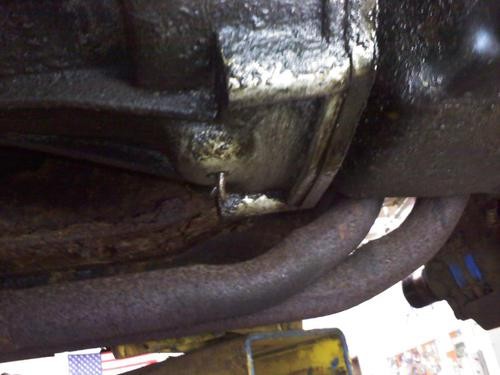The humble cotter pin, a simple piece of bent metal, plays a crucial, often overlooked role in your car’s transmission. Specifically, you might find a Transmission Pin hanging out near the bell housing, leaving you wondering about its purpose. This article delves into the function of this seemingly insignificant component, explaining why it’s vital for the health of your gearbox.
The Purpose of a Transmission Drain Pin
The transmission, like any mechanical system with moving parts, is susceptible to accumulating debris and moisture. To prevent this buildup from causing damage, most transmissions feature a small drain hole located at the bottom of the bell housing. This hole allows any unwanted particles or fluids to escape, ensuring smooth operation.
This is where the transmission pin comes in. Instead of a simple open hole, which could easily become clogged with dirt or road grime, a cotter pin is strategically placed in the drain hole.
 Cotter pin in Transmission (side view).jpg
Cotter pin in Transmission (side view).jpg
How the Cotter Pin Works
The cotter pin acts as a simple yet effective filter and drain. Its looped design allows fluids to drain while preventing larger particles from entering and blocking the hole. Furthermore, the pin’s inherent flexibility allows for slight vibrations, further discouraging clogs. This constant, subtle movement, coupled with capillary action, helps wick away moisture and prevents the buildup of oil within the bell housing.
While its primary function is to keep the drain hole clear, the transmission pin offers additional benefits:
- Preventing Corrosion: By allowing moisture to escape, the pin helps prevent corrosion inside the transmission casing.
- Early Warning System: A significant amount of metal shavings or debris caught on the pin could indicate internal wear and tear, providing an early warning sign of potential transmission problems.
Common Misconceptions about the Transmission Pin
There are several misconceptions surrounding the purpose of the transmission pin. Some believe it’s a safety device, while others think it’s related to lubrication. However, its primary function is solely to maintain a clear drainage path for contaminants and moisture. Pulling on the pin will not cause the car to explode or fly away!
A Low-Tech Solution with Lasting Impact
The use of a cotter pin as a drain plug exemplifies a simple, low-tech solution to a common automotive challenge. This design, originating as early as the 1920s in vehicles like the Ford Model A, continues to prove its effectiveness in modern vehicles. The transmission pin, a seemingly minor detail, demonstrates the clever engineering behind maintaining a critical component of your car.
Conclusion: The Unsung Hero of Your Gearbox
The transmission pin, while often overlooked, plays a vital role in preserving the longevity and efficiency of your transmission. By ensuring proper drainage and preventing the buildup of harmful debris and moisture, this simple cotter pin contributes significantly to the overall health of your vehicle. So, next time you’re under your car, take a moment to appreciate the ingenuity of this unsung hero of your gearbox.
